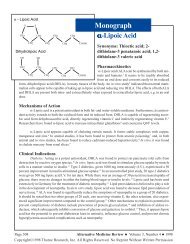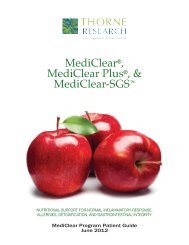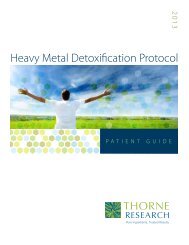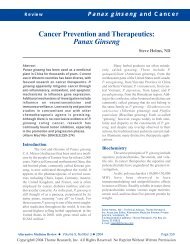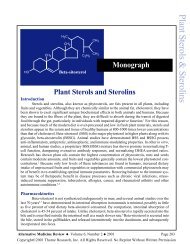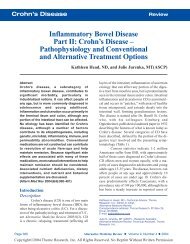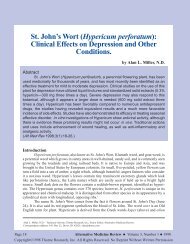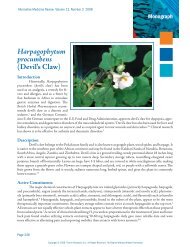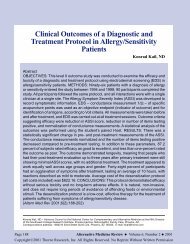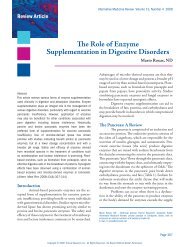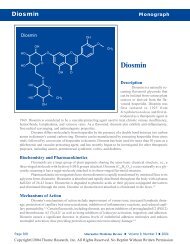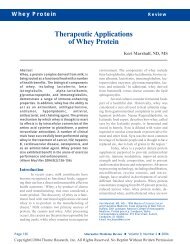Create successful ePaper yourself
Turn your PDF publications into a flip-book with our unique Google optimized e-Paper software.
<strong>Wound</strong> <strong>Healing</strong> Review<br />
and proteoglycan synthesis, and neoangiogenesis<br />
(proliferation phase); and by inhibiting wound<br />
remodeling. 78,79<br />
Experimental protein depletion in animals<br />
caused a decrease in the tensile strength of wounds.<br />
Rats fed a diet deficient in protein exhibited decreased<br />
wound integrity and strength versus control<br />
animals. 80 In a study of 108 human patients<br />
with experimental wounds, individuals with either<br />
low serum protein or serum albumin had significantly<br />
weaker wounds than those with normal protein<br />
values. 81<br />
Protein calorie malnutrition increases<br />
morbidity and mortality in the surgical/trauma<br />
patient. Many studies have found hospitalized<br />
patients in a state of malnutrition at admission.<br />
Thus, it is important to increase protein intake to<br />
optimize healing and immune function, and to<br />
prevent post-surgical complications in these individuals.<br />
82-84<br />
Protein supplementation of elderly patients<br />
with liquid protein formulas significantly<br />
enhanced healing of pressure ulcers. The change<br />
in ulcer area was significantly correlated with the<br />
amount of protein in the diet. 85<br />
The surgical or trauma patient exists in a<br />
state of metabolic stress, with the severity of the<br />
stress depending on the severity of the wounded<br />
state. An injured patient requires more protein than<br />
a non-injured patient because of the increased<br />
metabolic activity of wound healing, acute-phase<br />
protein production in response to stress, and amino<br />
acid mobilization from muscle used for hepatic<br />
gluconeogenesis.<br />
In a non-injured state, adults require approximately<br />
0.8 g dietary protein/kg body wt/day.<br />
Elderly patients have a higher protein requirement<br />
(1-1.2 g/kg body wt/ day) due to a decreased ability<br />
to synthesize proteins. The surgical/trauma<br />
patient can require significantly more protein.<br />
Minor surgery may not significantly increase the<br />
protein requirement; however, if the patient is already<br />
protein malnourished, wound healing will<br />
be adversely affected unless dietary protein intake<br />
is increased. Major surgery can increase protein<br />
requirements 10 percent, while a patient with<br />
multiple traumas may need 75-percent more protein.<br />
Burn wounds cause tremendous metabolic<br />
stress and have the greatest impact on protein requirements,<br />
increasing protein need 75-100 percent.<br />
86<br />
Table 1 summarizes nutrients recommended<br />
for perioperative nutritional support.<br />
Amino Acids in <strong>Wound</strong> <strong>Healing</strong><br />
It is well accepted that sufficient protein<br />
is necessary for wound healing. This appears to<br />
be due to the increased overall protein need for<br />
tissue regeneration and repair. <strong>Research</strong>ers have<br />
investigated the effects of specific amino acids on<br />
the healing process and determined that arginine<br />
and glutamine appear to be necessary for proper<br />
wound healing.<br />
Arginine<br />
Arginine is a non-essential amino acid that<br />
plays a key role in protein and amino acid synthesis.<br />
It is acquired from the diet and derived endogenously<br />
from citrulline in a reaction catalyzed<br />
by the enzyme arginine synthetase. Adequate tissue<br />
arginine appears to be essential for efficient<br />
wound repair and immune function. 87<br />
Arginine (17 g/day) was given to 30 elderly<br />
patients (>65 years of age) who sustained an<br />
experimental surgical injury. Supplemented patients<br />
demonstrated significantly greater hydroxyproline<br />
(a sign of collagen deposition) and protein<br />
accumulation at the wound site, compared to<br />
non-supplemented controls. Lymphocyte response,<br />
signifying greater immune activity, was<br />
elevated in the supplemented group, as was insulin-like<br />
growth factor-1, which is a control molecule<br />
for wound repair. 88 Other studies have found<br />
similar results. 89,90<br />
Glutamine<br />
Glutamine is used by inflammatory cells<br />
within the wound for proliferation and as a source<br />
of energy. 91,92 Fibroblasts use glutamine for these<br />
same purposes, as well as for protein and nucleic<br />
acid synthesis. Because optimal functioning of<br />
these cells is paramount to the healing process,<br />
glutamine is a necessary component of the process<br />
of tissue repair. Glutamine is a non-essential<br />
amino acid that can become a “conditionally es-<br />
Page 368 Alternative Medicine Review ◆ Volume 8, Number 4 ◆ 2003



